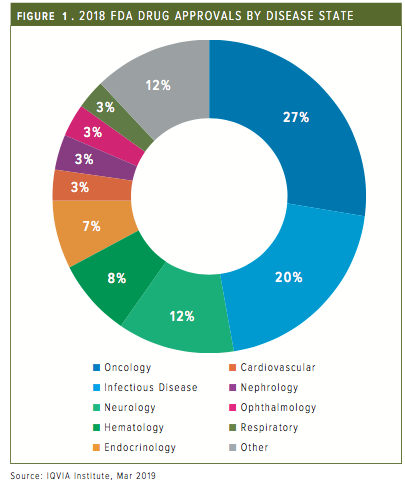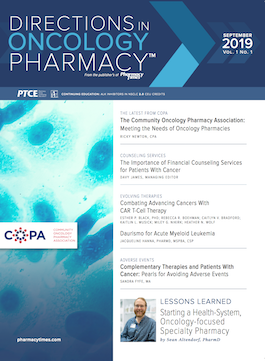Publication
Article
Pharmacy Practice in Focus: Oncology
Expanding Patient Channels to Oncology Products
Author(s):
As new specialty products have begun to dominate the developmental pipeline, specialty pharmacy has entered the mainstream of the supply chain to the point where we can arguably refer to much of the channel as “traditional specialty.”
It seems just a short time ago that a new model called “specialty pharmacy” emerged and the health care industry labored to understand what made this practice of pharmacy so different. Specialty products were unique, few and far between, as were the pharmacies that dispensed them. However, as new specialty products have begun to dominate the developmental pipeline, specialty pharmacy has entered the mainstream of the supply chain to the point where we can arguably refer to much of the channel as “traditional specialty.” Although specialty products account for approximately 5% of the total prescriptions filled in the United States, they are trending to account for more than 50% of overall pharmaceutical revenue.1 As a result, traditional pharmacy channels have been forced to increase their role in dispensing specialty medications. This shift in the pharma landscape has resulted in a significant expansion of access points for patients to specialty products. Our publications are responding to these trends accordingly, so stay tuned as we evolve our formats to keep our readers on the leading edge of pharmacy.
Specialty Pharmacy Is Not So Special Anymore
Many stakeholders would probably agree that the current specialty pharmacy model evolved from traditional community pharmacy. This happened when local, community-based independent pharmacy owners and pharmacists began to respond to the needs of patients regarding more complex drug regimens in the areas of HIV and transplantation. These pharmacies focused their efforts on gaining access to expensive medications; in the process, they developed expertise in obtaining coverage for them. Patients on these high-cost regimens require coordinated care, education, and professional engagement to stay compliant with the myriad drugs they were being prescribed to survive. As a result, community pharmacies became highly skilled in dispensing specialty pharmaceuticals, and thus the market came call them “specialty pharmacies.”
Currently, new drug approvals for more traditional disease states are rarer than they are for a rare disease, aside from generic or biosimilar products. In 2018, the majority of new drug approvals were for specialty products (Figure 1).

What accelerated these trends, in my view, was a shift toward generic drugs over the past 10 to 15 years as patents expired and were challenged. There are few traditional chronic diseases that lack a proven generically available product that can be used to competently treat these conditions. It is very difficult for pharma to differentiate branded products to succeed in this hypercompetitive market, especially in the face of payer formularies, reimbursement strategies, and $4-per-month generic programs.
Given the change in these dynamics, pharmacy and other providers have taken the deep dive into specialty, which is clear when examining the share of the market based on specialty revenues (Figure 2).

Clearly, we have moved away from retail and payers are now dominating the market in specialty. So what about the other nontraditional pharmacy channels? It is in this space that we are seeing an expansion, such as with in-home infusion, hospitals, and, to a greater degree, community oncology, which is pivoting from focusing on infusion to including oral oncology products.
We often think of specialty as being separate from other providers in the market, including pharmacy, but the reality is that specialty pharmacy is becoming crowded. This all sounds good for business, but what about the patient?
Oncology Specialty Pharmacy: Getting Back to the Core
Treating cancer requires a coordinated and specialized clinical approach to patient care, given the complexity of the disease, the variety of treatments, the management of adverse effects (AEs), and the associated lifestyle issues. A focused level of care for patients with cancer from pharmacists and other caregivers who are specially trained to support the specific requirements associated with oncology medications is paramount to achieving optimal outcomes. Comprehensive support for patients with cancer is crucial, especially those new to therapy.
These patients must understand how to take their medication and the often severe AEs that hinder adherence and gaining the full benefit of these drugs. Careful monitoring throughout the course of therapy and proactive outreach to physicians and patients helps to ensure that the prescription regimen remains on schedule. Comprehensive support services incorporating AE management are extremely important in helping a patient with cancer remain compliant. It is essential that all members of the specialty team understand the importance of patient interaction along every touchpoint, including when communicating with the reimbursement team or patient calls with nurses.
It is not just 1 medication that triggers an issue or leads to noncompliance. A comprehensive review of a patient’s total drug burden, including medications for comorbid conditions and OTC products, is essential and should be a standard part of any specialty pharmacy program. By understanding a patient’s comorbidities and nonspecialty medications, AEs such as those caused by drug-drug interactions, allergic reaction to medications, and therapy duplication can be avoided. In addition, rules that address maximum daily doses, cyclic excessive dosing, drug-age conflicts, and drug-pregnancy issues can be put in place.
Because patients have multiple touchpoints throughout the health care system that involve their drug therapy, more points in the channel are becoming engaged with specialty. Patients with cancer need to be managed throughout their treatment. The cost of treating their disease makes managing their health benefits vital. Clinicians need to be fully informed about the treatment programs to coordinate care. Pharmacists, especially those who specialize in oncology, are in an ideal position to help with care coordination since they are frequently engaged with patients and have expertise regarding their treatments and managing the AEs.
The Must-Haves to Be Special
Specialty pharmacies must be differentiated from traditional pharmacies because they focus on providing many aspects of patient care and disease management. For a pharmacy to be considered a specialty pharmacy, it must efficiently deliver medications that consider multiple factors, including the special handling, storage, and distribution requirements of these products.
A specialty pharmacy must focus on how every interaction with a patient can lead to optimal economic and clinical outcomes, particularly surrounding complex, rare, and chronic disease states, such as cancer. This can be achieved by deploying the integrated services of a team of qualified health care professionals who provide patients and caregivers with education that focuses on medication utilization, the importance of adherence, and potential alternatives to reduce unnecessary costs when appropriate. An effective team-based approach must foster an environment of information sharing between providers.
Given the high cost of these therapies, specialty pharmacy staff must be experts at seeking financial alternatives to help patients manage drug costs. If your pharmacy is not providing these must-have services, rest assured that another will. This is why we are seeing more traditional pharmacy players emerging from the “everyone else” category and joining the ranks of specialty.
Dan Steiber, RPh
References
1. Medicine use and spending in the U.S. IQVIA website. iqvia.com/institute/ reports/medicine-use-and-spending-in-the-us-review-of-2017-outlook-to-2022. Published April 19, 2018. Accessed July 9, 2019.







